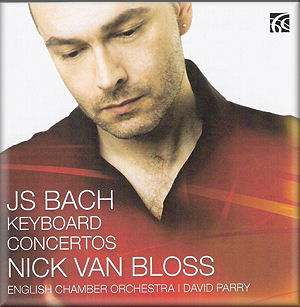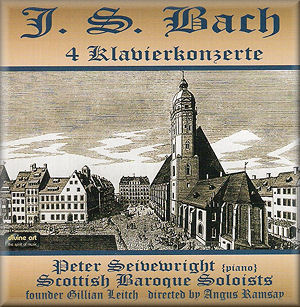 |
 |

Buy
through MusicWeb
for £ postage paid World-wide.
Musicweb
Purchase button
Sound samples and downloads |
Johann Sebastian BACH
(1685-1750)
Keyboard Concertos
Concerto in A major, BWV 1055 [13:43]
Concerto in G minor, BWV 1058 [13:36]
Concerto in D major, BWV 1054 [16:42]
Concerto in E major, BWV 1053 [19:19]
Concerto in F minor, BWV 1056 [10:07]
 Nick van Bloss (piano)
Nick van Bloss (piano)
English Chamber Orchestra/David Parry
rec. Henry Wood Hall, London, 18-20 July 2008, DDD
 NIMBUS ALLIANCE NI 6141 [73:22]
NIMBUS ALLIANCE NI 6141 [73:22]  |
| 

alternatively
CD: MDT
AmazonUK
AmazonUS
Sound Samples and Downloads
|
Johann Sebastian BACH
(1685-1750)
4 Klavierkonzerte
Concerto in G minor, BWV 1058 [14:31]
Concerto in D minor, BWV 1052 [22:25]
Concerto in E major, BWV 1053 [19:15]
Concerto in A major, BWV 1055 [15:05]
 Peter Seivewright (piano)
Peter Seivewright (piano)
Scottish Baroque Soloists/Angus Ramsay
rec. Academy Concert Hall and Alexander Gibson Opera Studio, RSAMD,
Glasgow, dates not supplied. DDD
 DIVINE ART DDA25030 [71:34]
DIVINE ART DDA25030 [71:34] |
| |
Here are two CDs which share three Bach keyboard concertos played
on the piano but take a different approach to performance and
accompaniment.
Nick van Bloss begins with Bach’s A major Concerto BWV 1055.
You can straightaway enjoy the blithe effect created by the
creamy, smooth tone and easy, nonchalant fluency he finds in
its opening movement; this notwithstanding the ebullience of
the predominantly semiquaver line in the right hand. This is
well complemented by the cheerful and lightly crisp articulation
of the orchestra. A dense, busy texture is delivered with a
gusto which never becomes hectic. In the Larghetto slow
movement the strings have a dreamy, faraway quality at first.
There’s then a growing tragic intensity in Parry’s sensitive
pointing of their succession of quaver/crotchet leaps and descents.
These are sweetly sad and them the piano plies an unbroken melody
whose bluesy elements are clearly revealed by van Bloss. Here
fluency doesn’t restrict the expressiveness of the cantilena.
In the finale a similar continuity is appreciable: you could
say it’s one long, bristling flourish from the piano. From the
orchestra an element of heady abandon emerges as the movement
lurches around in tipsy celebration. How vibrantly the strings
articulate the ornament of the second note mirroring that of
the piano part. It’s the ornamentation and demisemiquaver work
in the piano that creates the movement’s fundamental fervour.
Peter Seivewright ends his CD with this concerto. He plays with
an ensemble of solo strings plus double bass and guitar to boost
the continuo line. The atmosphere is more intimate, still closely
recorded. The drier Glasgow acoustic and more even balance of
piano and strings suits this approach. The same can be said
of the more dominant piano of the Nimbus recording to its more
standard concerto soloist/orchestra model. Seivewright’s playing
is rather steadier. The opening movement doesn’t therefore have
the flow of van Bloss/Parry. Seivewright and Angus Ramsay don’t
sweep you away, but you note more the structure of Bach’s argument.
Seivewright finds more contrast as that argument progresses,
pointing its different characteristics. In the outer movements
of all the concertos he leaves the opening to the strings, apart
from here the very first flourish, entering at the piano’s initial
elaboration of the theme (tr. 10, 0:21 and tr. 12, 0:31). This
points the opening solo entry more and makes it more akin to,
say, a Mozart concerto. I prefer the involvement of the piano
from the outset as in van Bloss’s account. Again in the slow
movement Seivewright’s phrasing is more marked, so the shape
of the piece is clearer. The piano melody is delivered with
more poise – it’s more like an aria - with an intensity that
more closely matches that of the accompaniment. The Seivewright/Ramsay
finale is more homely than the van Bloss/Parry, less virtuosic,
but the piano still skips along with plenty of liveliness.
Seivewright begins his CD with the G minor Concerto BWV 1058
and presents its opening Allegro in sinewy articulation
against strings. There’s considerable, lively energy here and
a rugged swing. But van Bloss is faster, timing at 3:42 against
Seivewright’s 4:05 and thereby more swinging still. He’s rather
lighter in tone yet with a turbulent verve, again with a headiness
of progression and Parry makes more appreciable the interplay
between soloist and orchestra because its forces – larger than
Ramsay’s chamber ensemble - give it more personality to meet
the soloist on equal terms. In the following Andante van
Bloss is smooth and laid back. He brings a beautifully flowing
line with the orchestra left to supply the edge of solemnity.
Seivewright offers a more shaped and expressive cantilena, very
much a soulful aria. Ramsay’s weeping solo strings are more
personally in emotive accord. To the finale van Bloss brings
both rigorous precision, which enhances its momentum, and a
playful bounce. Seivewright is steadier and more refined, but
this allows the piano to display more wit.
In the E major Concerto BWV 1053 opening movement van
Bloss brings an element of rugged muscularity of propulsion,
vigorous, flourishing. This is well counterpoised by Parry’s
defter strings in the myriad of contrapuntal exchanges. Seivewright,
on the other hand, is more lightly articulated and playful against
an ensemble that is more intimate, exploratory with a less distinctive
overall sense of direction. The following Siciliano from
Parry is a silkily veiled dance after which van Bloss’s solo
elaboration, presented with great clarity, gives it a reflective,
jocular cast. This seems a touch jarring, but van Bloss is right
to direct attention to the strangeness of a movement which contrasts
an extrovert form, a dance, with a soloist’s more inward musings.
Seivewright and Ramsay are more comfortable in their contrast
of emotive, lachrymose strings and a cooler, more limpid piano
solo unmistakably an aria. The result is that the whole movement
has more character. In the finale van Bloss/Parry (tr. 12) are
frolicsome and frothy, though with the episode featuring a chromatic
rise from 2:02 broadening things out more freshly for a spell.
Seivewright/Ramsay, if not as scintillating, are again more
lightly articulated, smoother, quite blithe and comely. They
manage to be more relaxed in manner though not in pace.
Now to consider the concertos van Bloss and Seivewright don’t
share. Seivewright plays the D minor Concerto BWV 1052.
I’m afraid I didn’t take to this account. In the opening movement
the piano sounds furtive, as if engaged in abstract doodling
and the scale seems too small for the nature of the work. Contrast
the busy, purposeful engagement of the 2000 recording by Murray
Perahia, piano director with the Academy of St Martin-in-the-Fields
(Sony
88697742912). Perahia fully exploits the tension the piano’s
sequences create, the offbeat strings’ interjections excite
and what a marvellous climax to the movement Perahia and the
orchestra achieve together. Seivewright’s slow movement finds
the piano cowed, the accompaniment thrust into a limelight it
finds tedious to sustain where Perahia is searingly reflective
in this ‘aria’ of huge tessitura. Seivewright’s finale, with
sprightly strings, is nicely done as a chamber piece but the
piano should surely be more commanding. Perahia gives us a maelstrom
of swirling energy.
Van Bloss plays two additional pieces: first the D major
Concerto BWV 1054. In the first movement he is playful yet
maintains momentum well, though for me he over bounces the attack
of the opening motif. As ever there’s fine interplay with the
orchestra and its evident involvement to enjoy. Perahia recorded
this concerto in 2001. His opening movement is smoother but
also jollier yet he also maintains a seamless vein of lyricism
and provides more light and shade than van Bloss. The slow movement,
gauzy and wistful, is beautifully realized by van Bloss. The
left hand piano melody is fastidiously balanced against the
right hand decoration. Still the emotion of the central section
is kept cool. Perahia makes the whole movement an arioso of
considerable eloquence born of suffering. The pathos of the
paring down of its centre is especially effective. To the finale
van Bloss brings a healthy robustness, but alongside this Bach
with bluster Perahia is more graceful, carefree and dance-like.
Van Bloss also plays the F minor Concerto BWV 1056. In
the opening movement (tr. 13) he supplies a creamy fluency as
a freewheeling contrast to the dour, stolid tutti at
the outset. An especially pleasing moment comes from 2:50 when
the left hand adds the movement’s main motif to the right hand’s
melodic flow. Perahia’s lyricism in this movement in his 2000
recording is both more seamless and tense yet also more varied
in tone and texture, but van Bloss’s blunter contrasts are just
as valid. The Largo slow movement is one of Bach’s loveliest
cantilenas. It comes from van Bloss in a bright, clean line
married with an absorbed, musing manner, toying with, yet very
fastidious in, its ornamentation. It’s cool and graceful, perhaps
a mite chintzy. Perahia is more velvety, makes the ornamentation
lighter yet more integral to the line. In the Presto
finale (tr. 15) van Bloss and Parry wittily point the interchange
between piano and orchestra from the orchestra’s echoing the
end of the piano’s first phrase. Van Bloss’s icy descending
trills, for example from 0:59, are also enjoyable. Nevertheless
I prefer the niftier pace (2:58 against van Bloss’s 3:19) and
lighter tone throughout achieved by Perahia and his accompanying
strings.
Both Seivewright and van Bloss contribute articulately and forcefully
to their CD booklets. Seivewright challenges the idea that Bach’s
keyboard concertos were simply arrangements of works for other
instruments while van Bloss charts his own approach to the range
of problems faced by performers using modern instruments. His
CD is the more striking. Van Bloss’s own distinctive style is
well matched by Parry’s orchestral verve. Seivewright is more
reflective yet is also complemented by Ramsay’s expressive chamber
ensemble. For a more rounded and eloquent approach to Bach concertos
played on the piano Perahia remains for me unsurpassed.
Michael Greenhalgh
See also review of NIMBUS ALLIANCE NI 6141 by Dominy
Clements
|
|

